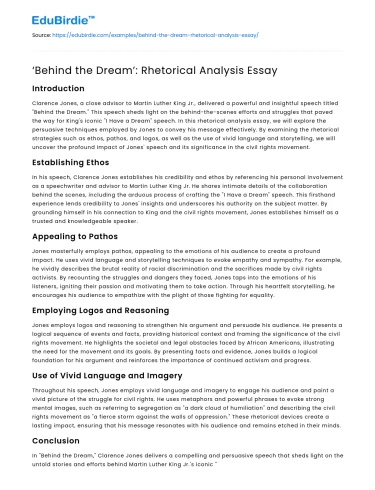Introduction
Clarence Jones, a close advisor to Martin Luther King Jr., delivered a powerful and insightful speech titled "Behind the Dream." This speech sheds light on the behind-the-scenes efforts and struggles that paved the way for King's iconic "I Have a Dream" speech. In this rhetorical analysis essay, we will explore the persuasive techniques employed by Jones to convey his message effectively. By examining the rhetorical strategies such as ethos, pathos, and logos, as well as the use of vivid language and storytelling, we will uncover the profound impact of Jones' speech and its significance in the civil rights movement.
Establishing Ethos
In his speech, Clarence Jones establishes his credibility and ethos by referencing his personal involvement as a speechwriter and advisor to Martin Luther King Jr. He shares intimate details of the collaboration behind the scenes, including the arduous process of crafting the "I Have a Dream" speech. This firsthand experience lends credibility to Jones' insights and underscores his authority on the subject matter. By grounding himself in his connection to King and the civil rights movement, Jones establishes himself as a trusted and knowledgeable speaker.
Save your time!
We can take care of your essay
- Proper editing and formatting
- Free revision, title page, and bibliography
- Flexible prices and money-back guarantee
Appealing to Pathos
Jones masterfully employs pathos, appealing to the emotions of his audience to create a profound impact. He uses vivid language and storytelling techniques to evoke empathy and sympathy. For example, he vividly describes the brutal reality of racial discrimination and the sacrifices made by civil rights activists. By recounting the struggles and dangers they faced, Jones taps into the emotions of his listeners, igniting their passion and motivating them to take action. Through his heartfelt storytelling, he encourages his audience to empathize with the plight of those fighting for equality.
Employing Logos and Reasoning
Jones employs logos and reasoning to strengthen his argument and persuade his audience. He presents a logical sequence of events and facts, providing historical context and framing the significance of the civil rights movement. He highlights the societal and legal obstacles faced by African Americans, illustrating the need for the movement and its goals. By presenting facts and evidence, Jones builds a logical foundation for his argument and reinforces the importance of continued activism and progress.
Use of Vivid Language and Imagery
Throughout his speech, Jones employs vivid language and imagery to engage his audience and paint a vivid picture of the struggle for civil rights. He uses metaphors and powerful phrases to evoke strong mental images, such as referring to segregation as "a dark cloud of humiliation" and describing the civil rights movement as "a fierce storm against the walls of oppression." These rhetorical devices create a lasting impact, ensuring that his message resonates with his audience and remains etched in their minds.
Conclusion
In "Behind the Dream," Clarence Jones delivers a compelling and persuasive speech that sheds light on the untold stories and efforts behind Martin Luther King Jr.'s iconic "I Have a Dream" speech. Through his effective use of ethos, pathos, and logos, as well as vivid language and storytelling, Jones captivates his audience and inspires them to reflect on the struggles of the civil rights movement. His speech serves as a call to action, urging listeners to continue the fight for equality and justice.






 Stuck on your essay?
Stuck on your essay?

